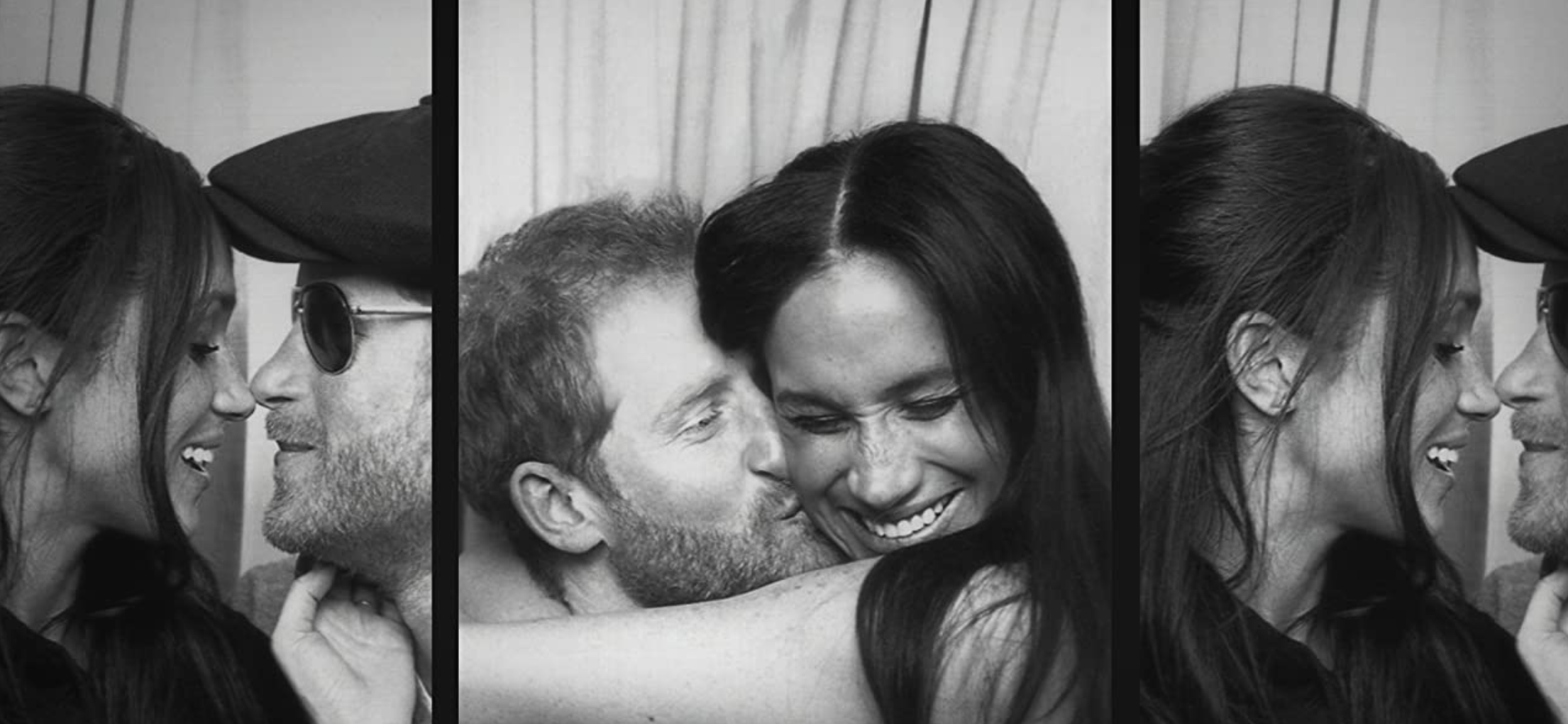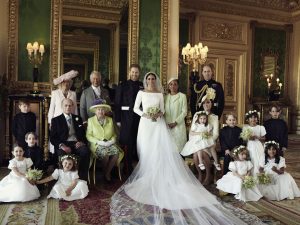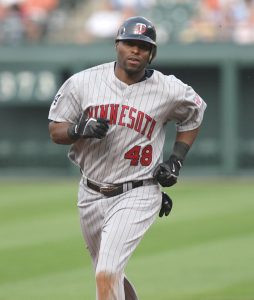The six-part docuseries tells the story of two cultures we don’t tend to think of as very different: the US and the UK.
You probably know the story. In classrooms across the country, children in the United States learn the familiar story of America’s origins: thirteen British colonies, an epic revolution, the major source of discontent over taxes paid to a king across the sea. As a result, Americans don’t often think of the United States and the United Kingdom as being very culturally distinct (after all, there’s a reason I’m writing this in English, not French or Spanish), except that the U.S. doesn’t have taxpayer-supported monarchy—the British institution under fire after Prince Harry’s dramatic exit from it following his marriage to American actress Meghan Markle.
The six-part docuseries Harry & Meghan, which dropped on Netflix in early December, tells the story of the couple’s romance, marriage, and eventual estrangement from the British monarchy through a mix of historical footage, family photos, news headlines, and interviews with family, friends, and intellectuals. Though marketed as a way for the Duke and Duchess of Sussex to tell their side of the story without tabloid interference, what emerges is a story about the wildly different attitudes that exist on either side of the pond about privacy, the press, and the role of race in a global context.
There’s a reason this docuseries appeals to U.S. audiences, and might leave a bad taste for British ones. The U.S. is framed as the refuge for the wayward royals: Their interviews are conducted alternately from a sprawling estate in California and a high-rise apartment in Manhattan with a view of the New York City skyline. Their desire to build a nuclear family away from the public eye resonates with American values of the right to privacy and individual liberty, without public or government interference in their affairs (but of course, they’ll invite millions of Netflix subscribers into their private lives). Meghan Markle, as an actress and activist from Los Angeles, embodies the exact parts of American fame that are incongruous with the British royal spotlight. Because she was accustomed to using her platform to advocate for social justice issues, she was unprepared for the “deliberately non-political” pedestals the British royals perch upon.
Instead of taking aim at the monarchy, the documentary points its arrow slightly askew, at the British press with which the monarchy maintains an intimate relationship. This framing allows the series to spend a lot of time covering the original People’s Princess, Diana. (If there’s one thing you want to take away about the Duke of Sussex, it’s that he really loved his mother.) Diana’s experience as a pariah of the royal family, and her tragic death in a car crash while she was evading the paparazzi, is a key aspect in understanding Prince Harry’s disdain for the British media. But the attention on the late Princess also comes in the wake of a revived interest in her, on the heels of Diana-centered docudramas such as The Crown and the Kristen Stewart-led film Spencer. The Sussexes draw parallels between the media’s harassment of Diana and its racist treatment of Meghan Markle, employing the memory of Diana’s suffering to underscore how terrible it was for the Duchess of Sussex.
The royal family’s attitudes toward the racism Meghan Markle endured at the hands of the British press is emblematic of the degree to which anti-Blackness is both ubiquitous and deeply ingrained in the U.K. Prince Harry describes other senior royals’ inability to understand why Markle’s media treatment is markedly worse than that of the white spouses, demonstrating how pervasive supposed colorblindness is in the British consciousness, and how its detrimental effects go largely unrecognized. Ignoring Meghan’s mixed race identity is a testament to the royals’ failure to see problems of racism in their country.
One of the Duchess’s comments early in the series is especially striking: when discussing her childhood, she discloses that until she entered the royal family, she “wasn’t treated like a Black woman, but as a mixed woman” (emphasis mine). In the backseat of a quiet car, Markle recounts a jarring incident of racism she witnessed, in which a white woman called her mother a slur. She recalls the incident with a visible steeliness. “It’s very different to be a minority and not be treated as a minority off the bat,” she says, referring to the anti-Blackness she saw her mother endure, the depth of which she did not experience because of her lighter complexion. “Obviously now, people are very aware of my race because they made it such an issue when I went to the U.K.,” Markle continues. “But before that … most people didn’t treat me like a Black woman.” Her words could have opened a thought-provoking conversation on passing and the dependency of racial identity on national contexts, but the series does not pursue it. The series says nothing about how Markle’s light skin almost certainly helped drive her acting career, nor does it reflect on the saliency of genealogy and heritage in the British context, which helped her connect to people of color across the Commonwealth.
Although the series doesn’t quite dive deep enough into the differences among conversations about race across national contexts, it successfully contextualizes the British monarchy’s dependence on the extraction of wealth from the neocolonial Commonwealth. Black British intellectuals Afua Hirsch, Kehinde Andrews, and David Olusoga provide the historical and cultural context for the narrative and stress the significance of Meghan Markle’s mixed-race identity to the Commonwealth, which is mostly made of people of color. Hirsch even refers to the Commonwealth as “British Empire 2.0.”
Through skillful editing of the Sussexes’ publicity tours, interviews with British subjects who profess their adoration of Markle, and commentary from the British intellectuals on the significance of Markle’s positionality, Harry & Meghan frames Markle’s entry into the British royal family as a symbolic victory for people of color throughout the Commonwealth. She is the window through which they can imagine themselves represented by the British Crown. But even if the British senior royals had treated her with the support she asked for, her victory would have been just that: symbolic. If Markle had remained a senior working royal, she would still be a Los Angeles-born, private school-educated actress whose success in part came from her ability to conform to the white beauty standard in Hollywood, which has answered calls for inclusion with colorism in hiring. The Sussexes come very close to this point with their explanation of the Commonwealth as the British neocolonial system, in which capital continues to flow out of formerly colonized countries to enrich the former colonizers, generation after generation.
Harry and Meghan’s mistake is in claiming that racism only exists in British press newsrooms, and is not baked into the system of the monarchy itself. Prince Harry comes so close to hitting the mark when he comments that Queen Elizabeth’s entire reign has been about preserving the monarchy—an institution that’s now fundamentally centered on nostalgia for the British Empire. And despite Markle’s appeal as “the new People’s Princess,” the wealth and luxury surrounding the Sussexes is inseparable from their story. Prince Harry’s global education and the couple’s impromptu trip to Botswana convey a level of privilege and ease of movement that only someone with generations of colonial wealth could access.
While their decision to step down from royal duties and to seek their own incomes might appeal to American values of hard work, the reality is that their wealth and privilege followed them to California, evident both in the Netflix deal that produced the show and in the sprawling estate in Montecito that forms its scenic backdrop. (Who can afford a lawn of that size in the drought-stricken Golden State?) If Harry and Meghan had stayed as working senior members of the royal family, what would they have actually achieved for Black Britons or Black Commonwealth subjects? Representation is important, but it’s also often an inch mistaken for a mile.
The unstated conclusion, which the docuseries never quite reaches, is one that appeals to U.S. audiences: abolition of the monarchy itself. Its reluctance to call for outright reform, let alone abolition, reflects the ongoing tension that continues to underwrite Harry and Meghan’s new lives. They are still the Duke and Duchess of Sussex, if now Americanized and half the world away from Buckingham Palace. Their show, combined with the recent publication of Prince Harry’s memoir, Spare, makes it clear that although the Duke and Duchess of Sussex have stepped down from their roles as working senior royals, much of their new self-made profit will come from their connections to and dramatic breakup with the British monarchy.
Even if it falls short of a truly refreshing call for change, the docuseries is a worthwhile watch and a compelling romance. Its unexpected strength is the way it situates U.S. and U.K. attitudes towards race, privacy, and representation through the story of Meghan and Harry. Go for the love story, stay for the history.





